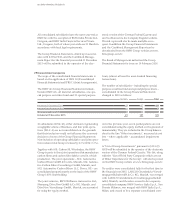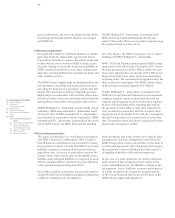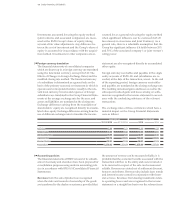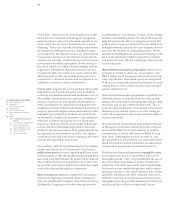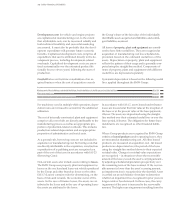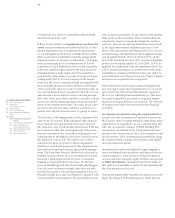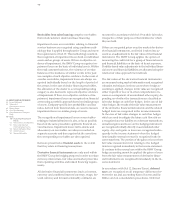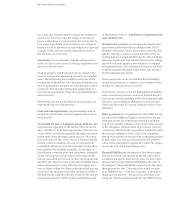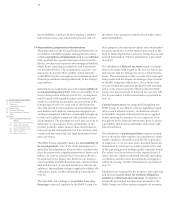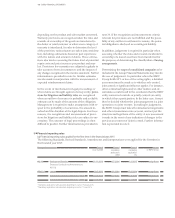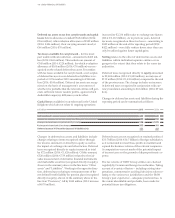BMW 2015 Annual Report Download - page 107
Download and view the complete annual report
Please find page 107 of the 2015 BMW annual report below. You can navigate through the pages in the report by either clicking on the pages listed below, or by using the keyword search tool below to find specific information within the annual report.107 GROUP FINANCIAL STATEMENTS
tax assets also include claims to future tax reductions
which arise from the expected usage of existing tax
losses available for
carryforward to the extent that fu-
ture usage is probable. Deferred taxes are computed
using enacted or planned tax rates which are expected
to apply in the relevant national jurisdictions when
the amounts are recovered.
Inventories of raw materials, supplies and goods for
resale are stated at the lower of average acquisition cost
and net realisable value.
Work in progress and finished goods are stated at the
lower of average manufacturing cost and net realisable
value. Manufacturing cost comprises all costs which
are directly attributable to the manufacturing process
and an appropriate proportion of production-related
overheads. This includes production-related deprecia-
tion
and an appropriate proportion of administrative
and social costs.
Borrowing costs are not included in the acquisition or
manufacturing cost of inventories.
Cash and cash equivalents comprise mainly cash on
hand and cash at bank with an original term of up to
three months.
Assets held for sale and disposal groups held for sale
are
presented separately in the balance sheet in accord-
ance
with IFRS 5, if the carrying amount of the relevant
assets will be recovered principally through a sale trans-
action rather than through continuing use. This
situa-
tion only arises if the assets can be sold immediately
in their present condition, the sale is expected to be
completed within one year from the date of classifica-
tion and the sale is highly probable. At the date of
classification, property, plant and equipment, intangible
assets and disposal groups which are being held for
sale
are measured at the lower of their carrying amount
and their fair value less costs to sell and scheduled depre-
ciation / amortisation
ceases. This does not apply, how-
ever, to items within the disposal group which are not
covered by the measurement rules contained in IFRS 5.
Simultaneously, liabilities directly related to the sale are
presented separately on the equity and liabilities side
of
the balance sheet as “Liabilities in conjunction with
assets held for sale”.
Provisions for pensions are recognised using the pro-
jected
unit credit method in accordance with IAS 19
(Employee Benefits). Under this method, not only
obli-
gations relating to known vested benefits at the
re-
porting date are recognised, but also the effect of future
increases in pensions and salaries. This involves taking
account of various input factors which are evaluated
on
a prudent basis. The calculation is based on an inde-
pendent actuarial valuation which takes into account
all relevant biometric factors.
Remeasurements of the net defined benefit liability
for pension plans are recognised, net of deferred tax,
directly in equity (revenue reserves).
Net interest expense on the net defined benefit liability
and / or net interest income on the net defined benefit
asset are presented separately within the financial result.
All other costs relating to allocations to pension pro-
visions
are allocated to costs by function in the income
statement.
Other provisions are recognised when the BMW Group
has a present obligation (legal or constructive) arising
from past events, the settlement of which is probable
and when a reliable estimate can be made of the amount
of the obligation. Measurement of provisions is based
on the best estimate of the expenditure required to settle
the present obligation at the end of the reporting
period. Non-current provisions with a remaining period
of more than one year are discounted to the present
value of the expenditures expected to settle the obliga-
tion at the end of the reporting period.
Financial liabilities are measured on first-time recogni-
tion at cost which corresponds to the fair value of the
consideration given. Transaction costs are also taken
into account except for financial liabilities allocated to
the category “financial liabilities measured at fair value
through profit or loss”. Subsequent to initial
recogni-
tion, liabilities are – with the exception of derivative
financial instruments – measured at amortised cost
using the effective interest method. The BMW Group




